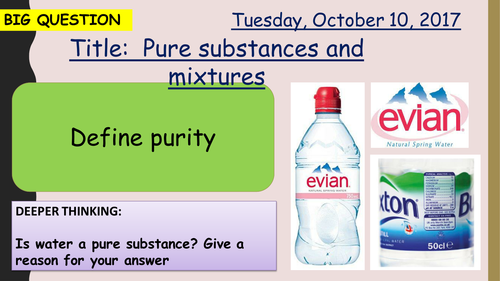
C10-Chemical analysis-Pure substances and mixtures lesson created in accordance to the NEW AQA Specification (9-1). Designed for a low ability year 11 class, although content can be adjusted to suit any ability. Includes: slide animations, embedded videos and practice questions with answers on slides as well as a interactive review task. If for any reason the video link does not work, a URL has also been included in the notes.
AQA spec link: 5.8.1.1 and 5.8.1.2
In chemistry, a pure substance is a single element or compound, not
mixed with any other substance.
Pure elements and compounds melt and boil at specific temperatures. Melting point and boiling point data can be used to distinguish pure substances from mixtures. In everyday language, a pure substance can mean a substance that has had nothing added to it, so it is unadulterated and in its natural state, eg pure milk. Students should be able to use melting point and boiling point data to distinguish pure from impure substances.
Many products are complex mixtures in which each chemical has a particular purpose. Formulations are made by mixing the components in carefully measured quantities to ensure that the product has the
required properties. Formulations include fuels, cleaning agents, paints, medicines, alloys, fertilisers and foods. Students should be able to identify formulations given appropriate information. Students do not need to know the names of components in proprietary products.
AQA spec link: 5.8.1.1 and 5.8.1.2
In chemistry, a pure substance is a single element or compound, not
mixed with any other substance.
Pure elements and compounds melt and boil at specific temperatures. Melting point and boiling point data can be used to distinguish pure substances from mixtures. In everyday language, a pure substance can mean a substance that has had nothing added to it, so it is unadulterated and in its natural state, eg pure milk. Students should be able to use melting point and boiling point data to distinguish pure from impure substances.
Many products are complex mixtures in which each chemical has a particular purpose. Formulations are made by mixing the components in carefully measured quantities to ensure that the product has the
required properties. Formulations include fuels, cleaning agents, paints, medicines, alloys, fertilisers and foods. Students should be able to identify formulations given appropriate information. Students do not need to know the names of components in proprietary products.
Something went wrong, please try again later.
I can always rely on paper friendly resources
Lots of AFL, Videos from industry and examples from industry. I would definitely recommend it.
Report this resourceto let us know if it violates our terms and conditions.
Our customer service team will review your report and will be in touch.
£4.00
